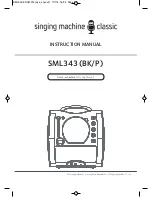
FABRICATOR 252i
BASIC WELDING
BASIC WELDING
4-12
Manual 0-5155
Art # A-07701
Figure 4-26: Single Run Vertical Fillet Weld
Art # A-07702
Figure 4-27: Multi Run Vertical Fillet Weld
Art # A-07703
Figure 4-28: Examples of Vertical Fillet Welds
2. Vertical Down
The E7014 electrode makes welding in this position
particularly easy. Use a 1/8" (3.2 mm) electrode at
100 amps. The tip of the electrode is held in light
contact with the work and the speed of downward
travel is regulated so that the tip of the electrode
just keeps ahead of the slag. The electrode should
point upwards at an angle of about 45º.
3. Overhead Welds
Apart from the rather awkward position necessary,
overhead welding is not much more difficult that
downhand welding. Set up a specimen for overhead
welding by first tacking a length of angle iron at right
angles to another piece of angle iron or a length of
waste pipe. Then tack this to the work bench or
hold in a vice so that the specimen is positioned
in the overhead position as shown in the sketch.
The electrode is held at 45º to the horizontal and
tilted 10º in the line of travel (Figure 4-29). The
tip of the electrode may be touched lightly on the
metal, which helps to give a steady run. A weave
technique is not advisable for overhead fillet
welds. Use a 1/8" (3.2 mm) E6013 electrode at 100
amps, and deposit the first run by simply drawing
the electrode along at a steady rate. You will notice
that the weld deposit is rather convex, due to the
effect of gravity before the metal freezes.
Art # A-07704
Figure 4-29: Overhead Fillet Weld
Distortion
Distortion in some degree is present in all forms of
welding. In many cases it is so small that it is barely
perceptible, but in other cases allowance has to be made
before welding commences for the distortion that will
subsequently occur. The study of distortion is so complex
that only a brief outline can be attempted hear.
The Cause of Distortion
Distortion is caused by:
A. Contraction of Weld Metal:
Molten steel shrinks approximately 11 per cent in
volume on cooling to room temperature. This means
that a cube of molten metal would contract approxi-
mately 2.2 per cent in each of its three dimensions.
In a welded joint, the metal becomes attached to the
side of the joint and cannot contract freely. Therefore,
cooling causes the weld metal to flow plastically, that
is, the weld itself has to stretch if it is to overcome the
effect of shrinking volume and still be attached to the
edge of the joint. If the restraint is very great, as, for
example, in a heavy section of plate, the weld metal
may crack. Even in cases where the weld metal does
not crack, there will still remain stresses "Locked-up"
in the structure. If the joint material is relatively weak,
for example, a butt joint in 5/64" (2.0 mm) sheet,
the contracting weld metal may cause the sheet to
become distorted.
















































